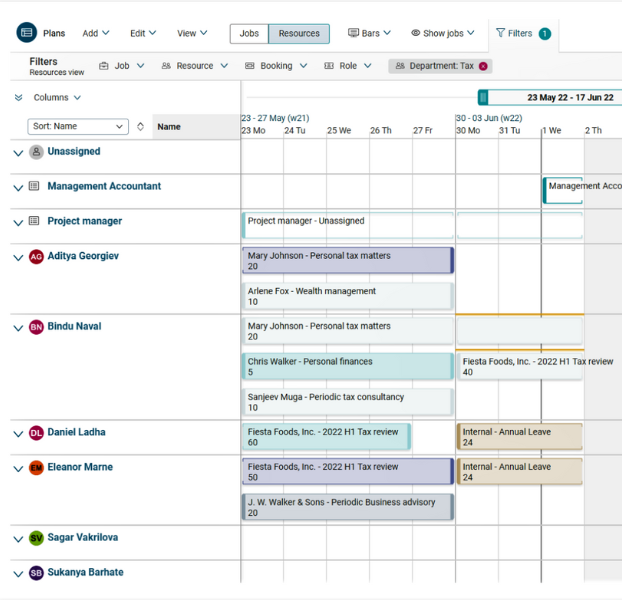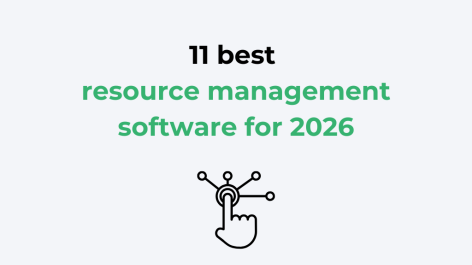Strategic resource planning can be a game-changer, boosting productivity, profitability, and operational efficiency. But what does strategic resource planning look like in action? How can best practices transform your bottom line? And, importantly, how can you plan resources more effectively and efficiently, especially in the era of remote work?
In this guide, we'll walk you through the ins and outs of resource planning and management. We'll show you how it can boost your return on investment (ROI), explore best practices, and offer some practical tips to help you get started.
Contents ?
- What is resource planning?
- Resource planning software vs Microsoft Excel
- 12 key benefits of resource planning
- Unlock increased ROI with effective resource planning
- How remote working affects resource planning
- Resource planning formula for success
- Future-proofing resource planning
- Poor resource planning costs money
- Case study: Mazars boosts operations cost-efficiency
- Summary
What is resource planning?
Let's start at the beginning – what is resource planning? Put simply, resource planning is a strategic approach that ensures all available resources, including people, skills, time, and materials, are used effectively and efficiently. ‘Resources' could be the team members working on a project, the time they have to complete tasks, or the budget allocated for a particular project. The goal is to get the job done in the most efficient way, and with client budgets, while maintaining a high level of quality.
Tasks that fall under resource planning can range from staff scheduling and project management to budgeting and demand forecasting. It's an ongoing process, always in motion, adjusting to the ever-changing landscape of your business operations.
But how do most people tackle resource planning? It’s often the battle of resource planning software vs. Excel. Let’s explore this further.?
Resource planning software vs Microsoft Excel
Many firms rely on Excel for workforce planning, but is it truly the most effective option? To help you decide let’s explore the limitations of Excel for resource planning and why specialised resource management software is becoming essential.
The pitfalls of Excel for resource management
While Excel is a familiar and accessible tool, it falls short when it comes to the complexities of resource management. Let's look at some of its limitations:
1. Limited visibility: Excel lacks a comprehensive view of resource utilisation across projects, hindering optimised assignments and staffing. Plus, siloed spreadsheets provide an incomplete picture, making it difficult to identify conflicts and plan effectively.
2. Manual hassle: Spreadsheets require constant manual adjustments, leading to tedious work and increased chances of errors. Consistently updating multiple files with many users is nearly impossible, and unconnected plans quickly degrade.
3. Inflexible planning: Excel lacks the flexibility to accommodate volatile projects and shifting priorities. Modelling scenarios and reallocating resources becomes clunky, requiring the reworking of multiple plans. And the absence of workflow rules adds ambiguity for users.
4. Weak analytics: While Excel can generate reports, manual analysis and number crunching are super labour-intensive. Pivot tables offer some assistance, but true automation is lacking, hindering fact-based forecasting and optimisation.
Why specialised resource management software is more effective:
On the other hand, resource management software, such as Retain, is purpose-built to tackle the unique challenges of people-powered services businesses. Here are some key capabilities that make it more effective:
?Holistic visibility: Resource management software provides real-time visibility into resource utilisation and availability through a centralised system. Drag-and-drop scheduling, allocation tracking, and intuitive analysis enable optimised assignments and staffing decisions.
?Workflow automation: Automation eliminates the manual work of updating spreadsheets, ensuring consistent and up-to-date data systemwide. Plus, changes and notifications happen in real-time across integrated plans.
?Flexible planning: Resource management software supports agile planning as projects evolve. Scenario modelling allows for "what-if" analysis, enabling quick resource reallocation. And workflow rules enhance efficiency and consistency.
?Powerful analytics: Embedded reporting and analytics offer data-driven insights. Dashboards track key metrics like utilisation rate, capacity vs demand, and project progress. And forecasting and modelling capabilities assist with long-term planning.
Making the switch from Excel to resource management software
Transitioning from spreadsheets to new software doesn’t need to feel like a significant change. Consider these key factors when adopting dedicated resource management software:
?Get stakeholder buy-in: Ensure company-wide enrollment by communicating the benefits and garnering input from managers, project leads, and staff. Plus, sharing success stories helps build support.
?Prioritise ease-of-use: When you’re used to Excel it’s helpful to choose software that facilitates existing processes and is intuitive and flexible. Solutions like Retain offer user-friendly interfaces and provide sufficient training resources and support. You even have the option to use booking bar fields or a table view (similar to Excel).
?Assess integrations: Determine which systems, such as HR, billing, or ERP, the software should sync with for maximum benefit. API integration potential is crucial for connecting plans across departments.
?Consider the cloud: Cloud-based solutions offer advantages like mobile access and faster updates. Evaluate security protocols and offline accessibility needs for your specific situation.
?Start small, then scale: Phased implementation allows users to acclimate and processes to refine before full rollout. Begin with one team or department and expand utilisation, gathering feedback along the way.
Case example: boosting profitability with resource management software
Pitcher Partners, a medium-sized accounting firm, experienced rapid growth that outpaced their resource planning capabilities. By implementing Retain resource management software, they gained organisation-wide visibility into resource availability and project demands, resulting in optimised staff utilisation and increased profitability.
Leave spreadsheets in the past
While Excel may be familiar, its limitations hinder resource management for professional services firms. Purpose-built software, like Retain, offers a modern solution optimised for people-powered businesses. Centralised data, automated workflows, scenario modelling, and data-driven insights provide immense benefits. Embrace the transition and position your firm for future success.
?You can read more about making the move from Excel to resource management software here.
With this in mind, let’s take a look at some of the benefits of best practice resource planning.?
12 key benefits of resource planning
Effective human resource planning (HRP) is the key to ensuring employee engagement and equipping your workforce with the necessary skills for success. So let’s take a look at the numerous benefits of HRP, its positive impact on employees, and the essential elements of a successful workforce plan.
When implemented effectively with the right tech, human resource planning offers a wide range of benefits:
1. Increased productivity: HRP ensures that employees are well-suited to their roles and equipped with the right skills and resources, leading to increased productivity. By addressing inefficiencies and bottlenecks, the right approach optimises project outcomes and enhances overall productivity.
2. Reduced costs: Effective HRP reduces turnover and associated recruitment and training costs. It also helps optimise staffing levels, preventing over or understaffing that can result in unnecessary expenses or lost revenue.
3. Adaptability to change: HRP enables businesses to create robust measures to cope with changing customer demands, business expansion, and external factors like political and economic conditions.
4. Retaining talent: By understanding factors that drive employee engagement, HRP allows you to create programs that support employee welfare, such as competitive compensation, employee engagement initiatives, and a positive work environment, fostering employee retention.
5. Quality hiring: HRP helps your company attract and hire highly qualified candidates by identifying the required skill sets for specific roles and developing effective interview processes. It also prepares your organisation for current and future staffing needs, supporting growth and expansion.
6. Meeting staffing needs: Effective HR planning ensures that your company's staffing needs are met, preventing potential problems associated with staff shortages. It allows proactive preparation for vacancies due to resignations or urgent hiring requirements.
7. Facilitating expansion programs: As your company grows, the demand for human resources increases. The right tech plays a vital role in scaling up through massive hiring or managing complex expansion initiatives like mergers and acquisitions.
8. Employee training and development: HRP enables the implementation of comprehensive onboarding and training programs, strengthening employee skills and knowledge. Equipped with the latest techniques and insights, employees can reach their targets and contribute to organisational success.
9. Effective performance management: Standardised performance reviews supported by HRP ensure fair and consistent evaluation of employees, fostering a transparent work environment and effective performance management.
10. Improved decision-making: HRP provides insights into future staffing needs and workforce challenges, empowering businesses to make informed decisions regarding staffing, training, and development. It enables agile responses to changes in the business environment.
11. Enhanced employee engagement and morale: When employees feel valued and supported, they are more engaged and motivated. HRP helps create a positive work environment and develop programs and policies that promote employee well-being, boosting morale.
12. Competitive advantage: By anticipating and addressing future needs, HRP allows businesses to stay ahead of the competition, attract top talent, develop innovative products and services, and respond effectively to market changes. This positions the business for long-term success.
To sum up, human resource planning offers numerous benefits for businesses, helping them grow and succeed. By embracing best practice approaches, your business gains a competitive advantage, attracts top talent, and builds a positive work environment.
? You can read more about the benefits of human resource planning here.
Pssst...You can easily plan your team’s best work with Retain’s resource management software. Get an accurate view of your team’s capacity, skills, charge rates, and client budget utilisation. I’m ready to go beyond spreadsheets?
Next up, let’s take a look at how effective resource planning impacts ROI.?
Unlock increased ROI with effective resource planning software
The best resource planning systems have a profound impact on ROI. By implementing the right strategies, your company can leverage resource planning systems to optimise operations and achieve remarkable returns. These strategies will help you streamline processes, enhance collaboration, and make informed decisions, ultimately maximising your ROI.
How does effective resource planning boost ROI?
In essence, the right resource planning software integrates various departments, facilitating seamless collaboration and information sharing. With real-time data and insights, teams can work together effectively, make better decisions, and enhance organisational efficiency:
?Improved efficiency: Resource planning software optimises production processes by providing visibility into the entire supply chain. This enables better planning, forecasting, and inventory management, leading to streamlined workflows, reduced bottlenecks, and enhanced resource allocation.
?Accurate job costing: Tracking and allocating costs associated with specific projects or jobs is made easier with resource planning software. Accurate job costing helps assess profitability, suggest accurate pricing, and identify areas for cost optimisation, leading to improved financial performance.
?Smarter cash flow management: Resource planning software provides real-time visibility into financial data, enabling effective cash flow management. With insights into accounts receivable, accounts payable, and cash flow, businesses can make informed decisions about expenses, investments, and revenue generation, supporting overall growth.
5 tips to increase resource planning ROI
To maximise the ROI of your resource planning software, consider implementing these tips:
?Employee training: Invest in comprehensive training programs to ensure employees are proficient in using the software. Well-trained users can maximise the system's capabilities, leading to improved efficiency and productivity.
?Executive buy-in: Secure buy-in from top executives and stakeholders within your company. Executive support drives user adoption and aligns the software with your strategic goals.
?Constant evaluation: Regularly assess whether the software meets your company's requirements, identify areas for improvement, and address any issues. This allows for timely adjustments and optimisation of the software's configuration.
?Accurate measurement: Establish key performance indicators (KPIs) to measure the impact and success of the resource planning software. Regularly track and analyse these metrics to assess ROI and identify opportunities for further optimisation.
?Avoiding common pitfalls: Be aware of common pitfalls such as data quality issues, poor system integration, and insufficient change management. Mitigate risks by addressing these challenges proactively, ensuring data cleanliness, robust integration planning, and effective change management.
Implementing a resource planning system can be a game-changer for your company's ROI. By adopting key strategies, leveraging resource planning software's benefits, and following best practices, you can drive significant returns. Unlock the full potential of your resources, optimise operations, and achieve remarkable ROI with smart resource planning.
?You can read more about improving resource planning ROI here.
?Discover your ROI from effectively managing your resources: Use our online calculator and discover your company's ROI in under 2 minutes: Show me my ROI >
Now that we’ve covered what resource planning is, why it’s time to ditch Excel, and the benefits and ROI of doing so, let’s take a look at the impact of remote working.?
How remote working affects resource planning
Remote work has gained immense popularity in recent years due to its numerous advantages. And one area where it can make a significant impact is resource planning. So let’s explore how remote work transforms resource planning and how leveraging resource management software can help overcome challenges and optimise the benefits of this new work trend:
?Wider pool of resources: With the right tech, geographical limitations no longer restrict resource managers. Instead, you can tap into a larger talent pool, collaborate across locations, and access cost-effective service centres. Plus, the removal of boundaries opens doors to recruit the best talent globally.
?More effective problem-sharing: Remote work facilitates better problem-sharing as knowledge is spread across a diverse group. However, managing a geographically dispersed team can present challenges. The good news? Resource management software with real-time data distribution ensures effective problem-solving and proactive resolution.
?Better collaboration: Remote work fosters focused collaboration, resulting in increased productivity and creativity. Resource management software centralises communication and critical materials, ensuring seamless collaboration regardless of location.
?Easier for international companies: Remote work eliminates geographical limitations, allowing seamless resource allocation between locations. Support and flexibility increase without the need for staff relocation or additional hires.
?Effective resource allocation: Remote work requires streamlined and dynamic resource planning. Resource management software simplifies this process, ensuring optimal allocation of resources to projects at the right time.
Remote work will undoubtedly impact resource planning, both positively and negatively. However, with a strategic approach and resource management software, your business can leverage this trend to optimise performance and drive bottom-line results. Embrace remote work, empower your teams, and streamline resource planning for success in the modern workplace.
?Read more about how remote working will affect resource planning here.
Next up, let’s now turn our attention to a resource planning formula for success.?
Resource planning formula success
Resource capacity planning plays a vital role in ensuring project success. It enables businesses to allocate the right resources, at the right time, with the right skills, ultimately leading to improved efficiency and productivity. But what is the formula for resource capacity planning success?
The resource capacity planning formula: calculating resources
Essentially, the resource capacity planning formula revolves around the concept of Full-Time Equivalent (FTE). Let's explore how to calculate FTE and utilise it in your planning process.
Calculating full-time equivalent (FTE)
To determine FTE, consider your company's full-time hours and the number of hours each employee works. Define your company's full-time hours by accounting for workdays, holidays, and daily work hours. For instance, in the UK, the average full-time work week is 40 hours, but it may vary for your organisation.
To calculate an employee's FTE, divide their working hours by your company's full-time hours. For example, an employee working 40 hours a week in a company with a 40-hour full-time schedule would count as 1 FTE. Adjustments can be made for those working longer or fewer hours.
FTE and availability
Employee absences impact resource capacity planning. Factor in planned absences, such as holidays, by assigning an FTE of 0 for those periods. Adjust an employee's FTE based on the number of hours they work during a given week, accounting for deviations from full-time hours.
Determining the number of employees needed
To ascertain the number of employees required for a project, calculate the total FTE needed by dividing the number of Person Days (PDs) required by the project duration (in days). Divide the project's FTE by the average FTE of your employees (e.g., 0.8 for full-time employees) to determine the number of employees needed.
Best practices for resource capacity planning
To optimise your resource capacity planning, follow these best practices:
✅Monitor real-time and effort: Gather accurate data on the time and effort required for tasks to make precise forecasts. Encourage team members to track their time using resource management software like Retain.
✅Keep competency information up-to-date: Stay informed about the competencies of your resources, ensuring you have the necessary skills available. Conduct meetings to highlight each individual's experience and strongest skill sets at the start of projects.
✅Identify potential bottlenecks: Proactively identify potential bottlenecks, such as insufficient personnel, equipment, or skill sets, to mitigate obstacles in your planning process.
✅Utilise multiple inputs: Consider factors like person-days, working hours, and resource locations when planning for resource capacity. Account for the unique dynamics of your industry.
✅Allow for potential mishaps: Include contingency time in your planning to accommodate unforeseen circumstances, ensuring you can handle unexpected challenges without jeopardising project timelines.
✅Calculate true work availability: Consider the actual productive time available to your team members, accounting for work-related tasks like meetings and email correspondence, to ensure realistic resource allocation.
The bottom line: By utilising the resource capacity planning formula and implementing best practices, businesses can effectively allocate resources, minimise bottlenecks, and optimise project outcomes. Embrace resource management software like Retain to streamline the process, ensuring you have the right people, skills, and workload for each project.
?You can read more on the resource planning formula for success here
If you’re wondering about how to future-proof your resource planning approach, next up we’ve got you covered. ?
Future proofing resource planning
Resource planning plays a critical role in addressing today’s resource challenges and future-proofing your approach. In this section, we explore the importance of future-facing resource planning systems and the need to replace legacy tools with modern solutions.
Replacing legacy tools
As we’ve touched on at the start of this guide, many firms struggle to future-proof their resource planning due to reliance on spreadsheet-based approaches. These methods lack the necessary visibility and control over the resource pool, making it difficult to assess utilisation rates, profitability, and match the right skills to each matter. Plus, legacy tools fall short in meeting the growing requirements and cost pressures of the industry.
Planning for the future
Forward-thinking firms should embrace a modern, scalable approach to resource planning to address disruptive changes. By leveraging advanced AI and ML capabilities, firms can automate resource allocation, identify available capacity, and assign matters efficiently. Retain offers the tools, technology, and expertise to support firms in their journey towards future-proofing resource planning.
To sum up, by replacing legacy tools with modern solutions, firms can gain complete visibility of their resource pool, optimise utilisation, and deliver client-centric services efficiently.
?You can read more about future-proofing resource planning here.
As well as providing a lack of visibility and efficiency, poor resource planning costs money too. Let’s explore this further.?
Poor resource planning costs money
Effective resource planning is essential for businesses looking to drive performance and optimise their bottom line. However, many organisations struggle with inefficient resource planning, leading to lost productivity, unnecessary spending, and employee attrition. In this section, we explore four symptoms of poor resource planning, their causes, and how your business can achieve healthy resource utilisation to thrive.
⚕️Symptom 1: Unnecessary spend on external resources
Lack of visibility into employee capabilities and skills results in unnecessary reliance on costly external resources. Without a mature approach to resource planning, businesses miss out on leveraging the unique skills and competencies of their workforce, hindering operational cost-effectiveness and impeding strategic goals.
⚕️Symptom 2: Uneven work allocation
Without a clear overview of employee capacity and project demands, workloads become imbalanced. Some employees may struggle with overwhelming to-do lists while others have underutilised time. This imbalance not only hampers efficiency but also leads to reduced client satisfaction and jeopardises client relationships.
⚕️Symptom 3: High employee turnover
Uneven work allocation, with some employees consistently overloaded and others lacking meaningful work, contributes to burnout and increased employee attrition. The costs associated with attrition, including lost productivity and recruitment expenses, can significantly impact business profitability and morale.
⚕️Symptom 4: Low responsiveness to change
Inability to identify unused capacity in the workforce hampers the ability to respond rapidly to new opportunities. With under-utilised resources and a lack of visibility into skills and availability, businesses may miss out on valuable engagements or fail to deliver optimal results, limiting growth potential.
?The cure: Effective resource planning
Effective resource planning addresses these challenges by allocating work in a balanced manner that considers individual skills and competencies. Advanced resource planning solutions, such as Retain, offer a comprehensive approach that optimises resource utilisation, reduces attrition, capitalises on opportunities, and minimises unnecessary spending on external resources.
If you recognise any of the symptoms mentioned, now is the perfect time to explore the benefits of advanced resource planning and unlock the potential of your workforce.
Effective resource planning is the key to maximising your business's performance and bottom line. By addressing the symptoms of poor resource planning and adopting advanced solutions like Retain, businesses can optimise resource utilisation, reduce unnecessary spending, and boost employee satisfaction. Don't let inefficient resource planning hold your business back. It's time to embrace the power of effective resource planning and unlock your organisation's full potential.
?You can read more about the cost of poor resource planning here.
What’s the best way to demonstrate the impact of best practice resource planning? Real-life success stories. Let’s take a look. ?
Case study: Mazars boosts operations cost-efficiency
Effective resource planning is critical for professional services firms like Mazars Qatar. With constantly changing project needs and employee availability, it can be challenging to ensure the right people are staffed at the right time.
Manual approaches to resource planning make it difficult to get a comprehensive view of utilisation and scheduling. This leads to suboptimal plans and greater reliance on costly external consultants.
Retain provided a solution with integrated analytics and automation to transform resource planning. The software delivers complete visibility into utilisation and availability across the organisation.
“As a professional services company, our people are our most valuable resource. We operate in a competitive space, and to maintain our market leadership while protecting our margins, it is vital that we keep our utilisation rates high.”
Key features include:
- Centralised database of employee skills, competencies, qualifications and availability
- Project planning tools to model resource requirements and identify gaps
- Scheduling engine to automatically assign resources based on skills and availability
- Utilisation tracking to optimise scheduling and identify spare capacity
- Reporting and analytics to gain insights from historical data
With Retain, professional services firms like Mazar can maximise utilisation of existing staff and reduce spend on external contractors. The data-driven approach replaces instinctual planning with accurate, real-time insights.
Mazars Qatar gained these benefits by implementing Retain:
- Time savings in the resource planning process by seeing availability and allocation instantly
- Increased utilisation of existing teams by optimising scheduling
- Cost reductions by minimising the need for external recruiting
The bottom line: By enhancing resource planning, Retain empowers professional services firms to boost margins and outperform competitors. The solution transforms a disjointed, manual process into a strategic advantage.
?You can read more about Mazar’s success story here.
Unlock your resources with Retain
If you’re looking to simplify resource planning, give Retain a try. Retain keeps all your resource-related information in one place, including simple, speedy scheduling, rapid resource planning, and easily pinpointing the right people. This makes it easy for you to meet customer targets, match people with the projects that suit their skills, and track if a project is running to budget.
And Retain’s new AI features make it easy for you to access intelligence resource recommendations and dynamic skills matching to find the right resources and skills. Plus AI models continuously learn and refine resource allocations strategies and suggestions over time. This means you're not just managing resources better today, but each day it's becoming increasingly effective for you.
To learn how Retain can help simplify and solve your resource planning, get a demo today.
Looking for more? Check out the most frequently asked questions below.?
Frequently Asked Questions
What is resource planning?
Resource planning is the process of forecasting and allocating an organisation's resources over a certain period to accomplish goals and objectives. It involves assessing resource needs, availability, and capacity to create an optimal plan for assigning resources to projects and tasks. An effective resource planning strategy maximises utilisation and productivity.
What is resource planning software?
Resource planning software like Retain is technology designed to optimise and automate resource planning across an organisation. It provides an easy-to-use centralised database to manage resource profiles, skills, budgets, and much more. Key features include demand forecasting, capacity planning, scheduling, utilisation tracking, and analytics. Resource planning software gives real-time visibility into resource allocation and availability. This enables better planning decisions to maximise productivity and utilisation, and enhances human resource management.
How to do resource planning?
Effective resource management involves several key steps:
- Assess upcoming resource needs based on goals, projects, and forecasts
- Take stock of available project resources and their skills/capabilities, plus any project requirements for each entire project
- Compare needs to availability to identify gaps and project tasks
- Develop options to address gaps, like hiring, training, or contingency plans
- Create an optimised schedule that aligns resources with specific tasks and timeframes and ensures you manage projects on time
- Continuously monitor utilisation and adjust plans as needs change for future projects and your changing resource schedule
Using a resource planning tool like Retain streamlines these steps. Retain centralises resource and project data, enables scenario planning, prevents resource constraints, provides real-time visibility into utilisation, and automates scheduling based on availability and skills. This makes resource planning easier, more efficient, and more accurate and helps you develop a robust resource management plan.




